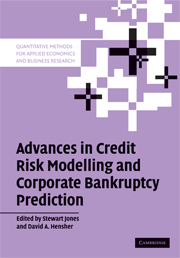Book contents
- Frontmatter
- Contents
- List of figures
- List of tables
- List of contributors
- Introduction
- 1 A statistical model for credit scoring
- 2 Mixed logit and error component models of corporate insolvency and bankruptcy risk
- 3 An evaluation of open- and closed-form distress prediction models: The nested logit and latent class models
- 4 Survival analysis and omitted dividends
- 5 Non-parametric methods for credit risk analysis: Neural networks and recursive partitioning techniques
- 6 Bankruptcy prediction and structural credit risk models
- 7 Default recovery rates and LGD in credit risk modelling and practice: An updated review of the literature and empirical evidence
- 8 Credit derivatives: Current practices and controversies
- 9 Local government distress in Australia: A latent class regression analysis
- 10 A belief-function perspective to credit risk assessments
- Index
- References
8 - Credit derivatives: Current practices and controversies
Published online by Cambridge University Press: 11 June 2010
- Frontmatter
- Contents
- List of figures
- List of tables
- List of contributors
- Introduction
- 1 A statistical model for credit scoring
- 2 Mixed logit and error component models of corporate insolvency and bankruptcy risk
- 3 An evaluation of open- and closed-form distress prediction models: The nested logit and latent class models
- 4 Survival analysis and omitted dividends
- 5 Non-parametric methods for credit risk analysis: Neural networks and recursive partitioning techniques
- 6 Bankruptcy prediction and structural credit risk models
- 7 Default recovery rates and LGD in credit risk modelling and practice: An updated review of the literature and empirical evidence
- 8 Credit derivatives: Current practices and controversies
- 9 Local government distress in Australia: A latent class regression analysis
- 10 A belief-function perspective to credit risk assessments
- Index
- References
Summary
Introduction
In this chapter we explore the rapid growth of the credit derivatives market over the past decade, including the most important economic and regulatory factors which have contributed to this growth. We explain and contrast a wide range of credit derivative instruments, including credit default swaps, credit linked notes, collateralized debt obligations (CDOs) and synthetic CDOs. Credit default swaps and synthetic CDOs have evidenced the greatest growth in recent years as these have emerged (inter alia) as a highly effective tool for hedging credit risk exposure and providing investors with a wide range of new investment and diversification opportunities. While many prominent commentators have touted the wide reaching benefits of credit derivatives in the financial markets, others have taken a more cautious view and have expressed concerns about the potential threats to financial stability when risk is too widely spread throughout the economy, particularly to counterparties who may not be subject to the same level of regulatory scrutiny as banking institutions. Other concerns have been voiced that credit derivative markets have not been tested in a serious economic downturn. This ‘test’ seems to have come a little sooner than expected with the‘sub-prime’ meltdown in the United States, which first came into public prominence from June 2007. The sub-prime crisis had an immediate and devastating impact on world equity and debt markets generally, and credit derivative markets in particular.
- Type
- Chapter
- Information
- Publisher: Cambridge University PressPrint publication year: 2008
References
- 1
- Cited by

